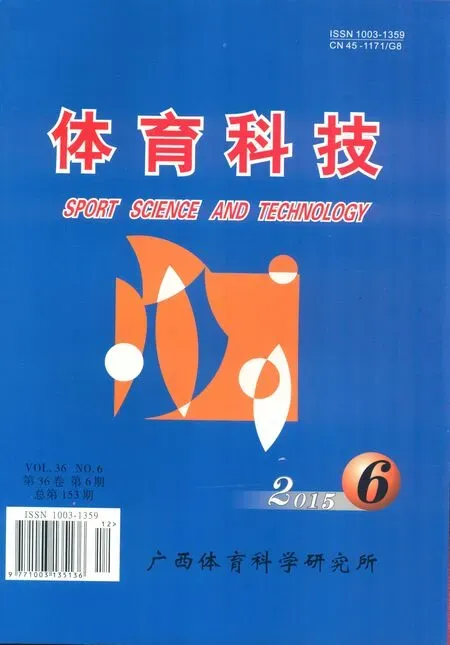SIRT3与氧化应激及其与运动关系的研究进展
陈贝贝
(上海市华东师范大学,上海 200241)
SIRT3与氧化应激及其与运动关系的研究进展
陈贝贝1
(上海市华东师范大学,上海 200241)
Sirt3在细胞凋亡和细胞内的信号转导中具有重要作用,参与调节线粒体的生物发生等功能,同时也受能量限制和适度运动的影响。在总结Sirt3与细胞线粒体功能重要相关机制的基础上,结合运动与Sirt3的研究现状,展望Sirt3在运动与能量平衡及衰老关系中的研究前景,以期为探索肥胖与骨骼肌衰减的发病机理提供科学依据。
Sirt3;氧化应激;细胞线粒体
依赖烟酰胺腺嘌呤二核苷酸(nicotimide adenosine dinucletide,NAD)的组蛋白去乙酰化酶Sirtuins属于沉默信息调节因子2(silent information regulartor 2,SIR2)家族,是定位于哺乳动物细胞线粒体的去乙酰化酶[1]。自2000年以来sirtuins(SIRT1-7)已经逐渐受到重视,因为它们与一些生物学过程相关如细胞新陈代谢调节、神经保护作用、凋亡、炎症和癌症进程[2]。Sirt3是Sirtuins家族成员之一,主要被定位在线粒体,通过对几个与新陈代谢和呼吸相关酶的脱乙酰基作用来调控线粒体的功能[3]。
1 SIRTUINS家族与氧化应激
Sirtuins是高度保守的NAD+依赖的蛋白去乙酰化酶或ADP核糖基转移酶,它涉及一些细胞的进程包括基因组稳定性、细胞生存、氧化应激反应、新陈代谢和衰老[4]。在哺乳类动物仅有7种sirtuins(Sirt1-7)表达。它们分布在离散的亚细胞隔间:Sirt1、Sirt6和Sirt7主要位于细胞核,Sirt2位于细胞质,Sirt3、Sirt4和Sirt5主要位于线粒体[5]。
在不同的组织器官,Sirt1可能通过不同的细胞内转录因子如p53,核转录因子-Kb(nuclear factor kappa B,
NF-kB)等间接抵抗氧化应激,还可以对一些蛋白进行去乙酰化作用进而缓解氧化应激损伤。 Sirt4涉及调节体内能量的平衡,同时也与ROS的产生相关[6, 7]。
1.1 SIRTUINS参与抵抗心血管的氧化应激损伤
内皮细胞在维持血管内稳态中扮演重要的角色,内皮功能紊乱涉及一些心血管疾病的进程如高血压、动脉粥样硬化和心衰。Sirtuins在一定程度上可以调节内皮细胞的氧化应激损伤[8]。UCP2是位于线粒体内膜的跨膜蛋白,它可以使质子内流时绕过ATP合酶,不产生氧化磷酸化(ATP)合成,使能量以热能形式释放。UCP2的主要生理作用是调节能量代谢,调控ROS的产生等。周曦等[9]实验研究发现Sirt1经白藜芦醇激活能够抑制UCP2的表达,降低细胞内ROS水平,进而减少ROS引起的血管内皮细胞损伤。UCP2也参与线粒体Sirt3的抗氧化作用[10]。也有研究[11]表明在氧化应激状态下Sirt6可能受到抑制,而Sirt6的过表达能够降低氧化应激诱导的内皮细胞损伤。提示:Sirt1和Sirt6都具有调节内皮细胞的氧化应激损伤的作用。然而也有实验结果表明Sirt6的内皮细胞保护作用是通过Sirt6自身直接调节的,并不受其
Sirtuins家族成员的影响[12]。虽然有研究证实Sirt1在内皮细胞抗氧化应激的角色,但是否Sirt1与Sirt6在内皮细胞抗氧化应激中发挥协同抗氧化作用或者Sirt6妨碍Sirt1抗氧化作用,还不清楚,需要进一步的证实。此外,也有研究[13]表明在内皮细胞Sirt2的抑制剂AGK2的预处理能够降低H2O2诱导的细胞毒性作用,提示:在氧化应激状态下,Sirt2通路对细胞生存能力可能存在有害的作用。氧化应激状态下,Sirt2也与细胞增殖扩散和肿瘤的生长相关[14]。
1.2 SIRTUINS对神经系统的保护作用
Sirt1在缓解心肌细胞和星形胶质细胞氧化应激损伤中也扮演一定的角色。有研究[15]发现Sirt1的过表达诱导ROS产物的减少进而降低阿霉素引起的心肌细胞凋亡。Verma[7]等研究显示通过Ca2+或苯砷氧化物(Phenylarsine
oxide,PAO),线粒体渗透性转换孔(Permeability
transition pore,PTP)的诱导伴随ROS的产生,而Sirt4的耗尽也可通过Ca2+或PAO途径抑制ROS的生成。过表达的Sirt4可以显著增加H9c2细胞的生存能力,同时显著降低凋亡细胞的比值[16]。在HEK293T细胞,Sirt4的短暂敲除引起耗氧量的增加,相反的,Sirt4过表达导致耗氧量下降,在一定程度上影响氧化磷酸化作用的有效性[6]。
2 SIRT3与氧化应激
哺乳动物细胞中的sirtuins家族,是一种高度保守并依赖烟酰胺腺嘌呤二核苷酸(NAD)的组蛋白去乙酰化酶。Sirt3是位于线粒体并调节线粒体呼吸作用和氧化应激抵抗的Ⅲ类去乙酰化酶之一。
2.1 sirt3与线粒体氧化应激
在冷暴露、能量限制和运动等应激状况下,Sirt3 RNA水平上升,相反在高脂膳食等状况下,Sirt3 RNA水平下降,提示:应激诱导Sirt3的表达。Sirt3主要通过调节ROS的产生和清除来缓解线粒体氧化应激。Sirt3可能通过作用于电子呼吸链复合物1、2、3和线粒体通透性转换孔等调节ROS的产生。例如Sirt3能够去乙酰化FOXO3的赖氨酸残基K271和K290,进而降低FOXO3的磷酸化、泛素化和降解,使得FOXO3蛋白稳定,之后依赖FOXO3的线粒体抗氧化酶包括锰超氧化物歧化酶等。
之前对Sirt3的研究主要集中于在一些病理学如心力衰竭、糖尿病、心血管疾病等过程中通过药物引起Sirt3激活促进下游的靶分子的去乙酰化进而上调抗氧化酶MnSOD、CAT等的活性以抵抗氧化应激。
3 Sirt3与运动的关系
目前运动是公认的延缓衰老、防治肥胖以及其它代谢类疾病的有效手段,其作用机制也一直是研究的重点。而运动对Sirtuins家族和氧化应激的影响也得到了极大的关注。一般来讲,运动在一定程度上可提高Sirt3的活性进而直接或通过其下游靶分子抵抗氧化应激。Vargas等[17]的实验证实有氧训练可提高男性青少年骨骼肌Sirt3的表达。
[1]Balcerczyk, A.and L.Pirola, Therapeutic potential of activators and inhibitors of sirtuins.Biofactors, 2010,36(5):383.
[2]Mellini, P., S.Valente and A.Mai, Sirtuin modulators: an updated patent review (2012 - 2014).Expert Opin Ther Pat, 2015,25(1):5-15.
[3]Onyango, P., et al., SIRT3, a human SIR2 homologue, is an NAD-dependent deacetylase localized to mitochondria.Proc Natl Acad Sci U S A, 2002,99(21):13653.
[4]Parihar, P., etal., Mitochondrial sirtuins: emerging roles in metabolic regulations, energy homeostasis and diseases.Exp Gerontol, 2015, 61: 130-41.
[5]Houtkooper, R.H., E.Pirinen and J.Auwerx, Sirtuins as regulators of metabolism and healthspan.Nat Rev Mol Cell Biol, 2012,13(4):225.
[6]Ho, L., et al., SIRT4 regulates ATP homeostasis and mediates a retrograde signaling via AMPK.Aging (Albany NY), 2013,5(11):835.
[7]Verma, M., N.Shulga and J.G.Pastorino, Sirtuin-4 modulates sensitivity to induction of the mitochondrial permeability transition pore.Biochim Biophys Acta, 2013,1827(1):38-49.
[8]Le Brocq, M., etal., Endothelial dysfunction: from molecular mechanisms to measurement, clinical implications, and therapeutic opportunities.Antioxid Redox Signal, 2008,10(9):1631.
[9]周曦等.SIRT1/UCP2通路在白藜芦醇抑制血管内皮细胞氧化应激损伤中的作用.第三军医大学学报,2013(16): 1671-1675.
[10]Gounden, S., et al., Increased SIRT3 Expression and Antioxidant Defense under Hyperglycemic Conditions in HepG2 Cells.Metab Syndr Relat Disord, 2015.
[11]Cardus, A., et al., SIRT6 protects human endothelial cells from DNA damage, telomere dysfunction, and senescence.Cardiovasc Res, 2013,97(3):571.
[12]Liu, R., et al., Oxidative stress induces endothelial cell senescence via downregulation of Sirt6.Biomed Res Int,2014.
[13]Liu, J., et al., Global Gene Expression Profiling Reveals Functional Importance of Sirt2 in Endothelial Cells under Oxidative Stress.Int J Mol Sci, 2013.14(3):5633.
[14]Xu, Y., et al., Oxidative stress activates SIRT2 to deacetylate and stimulate phosphoglycerate mutase.Cancer Res,2014,74(13):3630.
[15]Ruan, Y., et al., SIRT1 suppresses doxorubicin-induced cardiotoxicity by regulating the oxidative stress and p38MAPK pathways.Cell Physiol Biochem, 2015,35(3):1116.
[16]Liu, B., et al., SIRT4 prevents hypoxia-induced apoptosis in H9c2 cardiomyoblast cells.Cell Physiol Biochem, 2013,32(3):655.
[17]Vargas-Ortiz, K., et al., Aerobic Training Increases Expression Levels of SIRT3 and PGC-1alpha in Skeletal Muscle of Overweight Adolescents Without Change in Caloric Intake.Pediatr Exerc Sci, 2015,27(2):177.
SIRT3 and Oxidative Stress and the Research Progress of the Relationship of It with the Sports
CHEN Bei-bei
(Eeast China normal university, Shanghai 200241, China)
Sirt3 in cell apoptosis and plays an important role in intracellular signal transduction, participate in the regulation ofmitochondrial functions such as biological, but also restricted by the energy and the impact of moderate exercise.Importantmechanisms in summary Sirt3 and cell mitochondrial function, on the basis of combination of sports and Sirt3 research present situation, prospect of Sirt3 research in motion and energy balance and aging relations, so as to explore the pathogenesis of obesity and attenuation of the skeletal muscle to provide scientific basis.
Sirt3; oxidative stress; cell mitochondria
陈贝贝(1988- ),河南焦作人,研究生,研究方向:运动与适应。

